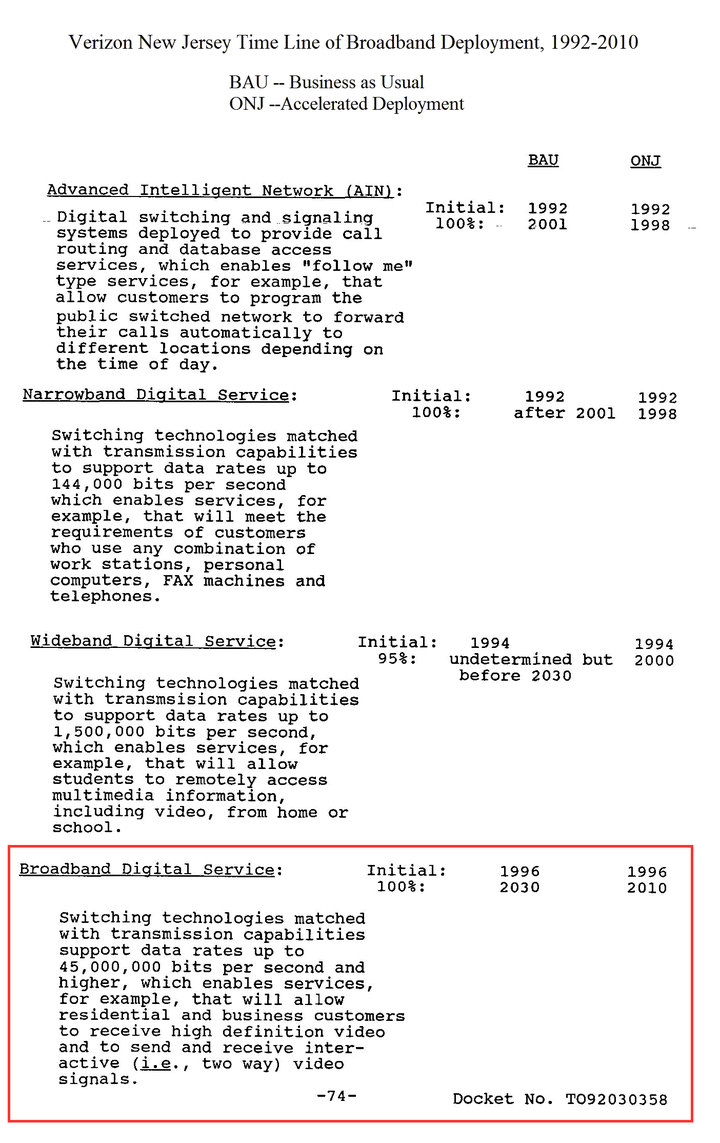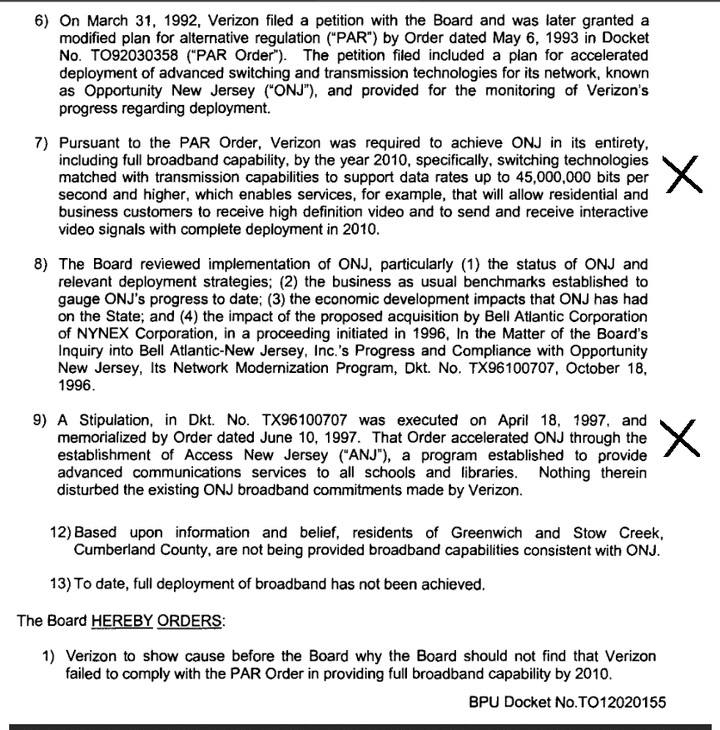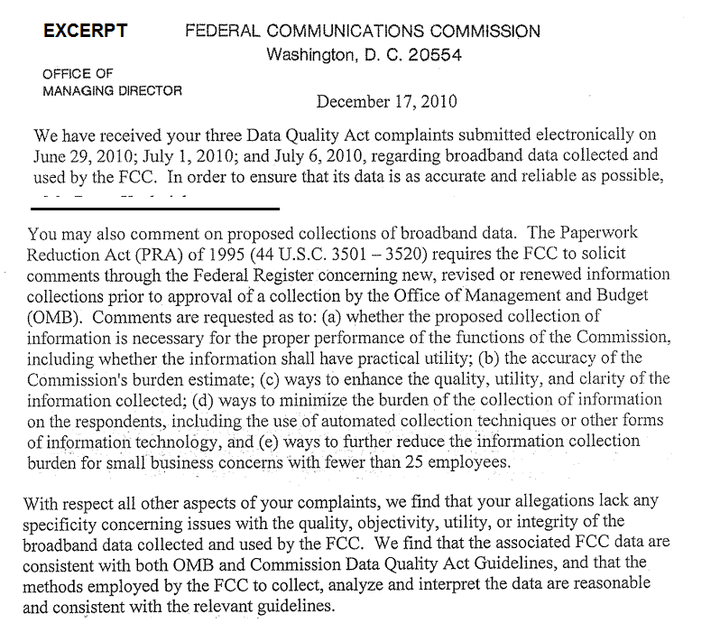Part II Let’s go through what was left out of the FCC’s reports.
- The Fiber Optic Scandal: 100% Doesn’t Mean 100%
This excerpt is from the Verizon Opportunity New Jersey Order of 1993. Verizon was supposed to be offering 45 Mbps, bi-directional services, starting in 1996. And again, this was an upgrade of the state utility, Verizon New Jersey, that would replace the existing copper infrastructure with fiber optic wires. And this was the standard definition of broadband in multiple states.
This is the actual timeline from the Order. By 2010, 100% of Verizon NJ would be upgraded to fiber, and this would be at 45 Mbps, in both directions. If you notice there is also a “business as usual” timeline which says – I paraphrase: If you don’t change the laws and give us more profits, tax perks and rate increases, this broadband future will be done in the year 2030.

We bring this up because no FCC 706 report mentions that this was the speed in America and these were the plans that the FCC was supposed to be tracking—but didn’t.
In fact, in 2012 the New Jersey Board of Public Utilities issued a show cause order – mentioning that Verizon had not fulfilled its obligations: (The “alternative regulation” is deregulation, and this show cause order specifically gives the speed as 45 Mbps.)
- How Many Times Did We Pay for the Wiring of Schools?
Notice that fiber was also supposed to be going into every school and library starting in 1997 in New Jersey.
The FCC has never mentioned the state broadband commitments to schools or that obligations were built into state law and charged to customers. And yet, Section 706 mandates state and federal incentives.
SEC. 706. ADVANCED TELECOMMUNICATIONS INCENTIVES.
(a) IN GENERAL- The Commission and each State commission with regulatory jurisdiction over telecommunications services shall encourage the deployment on a reasonable and timely basis of advanced telecommunications capability to all Americans (including, in particular, elementary and secondary schools and classrooms) by utilizing, in a manner consistent with the public interest, convenience, and necessity, price cap regulation, regulatory forbearance, measures that promote competition in the local telecommunications market, or other regulating methods that remove barriers to infrastructure investment.
- Rural Areas – And the Wireless Replacement of Fiber Optics
This show cause order was created because two small towns, Stow Creek and Greenwich NJ were not upgraded. In 2012, we filed on behalf of the towns and the State required Verizon NJ to upgrade the towns.

However, with the help of Governor Christie, Verizon was able to get a ‘stipulation agreement’ passed to allow wireless at the speed of DSL to replace any more fiber buildouts—even though 1/3-1/2 of the State was never completed.
To summarize:
- State laws and regulations were changed in 1993 to provide a fiber optic future from Verizon—and charge local phone customers.
- In 1997, the State added—all schools and libraries would be upgraded.
- By 2004, nothing had been deployed.
- In 2005, Verizon was granted a cable franchise ‘system wide’ for FiOS – ignoring the previous state commitments.
- By 2010, Verizon announces the plan to stop FiOS.
- In 2012, two towns complain and get upgraded.
- In 2014, Gov. Christie’s appointee creates a ‘Stipulation Agreement’ with Verizon.
- The agreement allows for the substitution of wireless at DSL speeds.
None of the state commitments, the failure to deploy, the replacement of the copper wires, the commitments to wire the schools, the bait and switch to provide wireless vs finishing the buildouts, were ever even mentioned by the FCC over the last 20 years of Section 706 reports, much less that the customers were de-facto investors.
And, in 2014, the speed of broadband, in state law, was still 45 Mbps in both directions — but never mentioned in any 706 report, nor was replacing a fiber optic commitment with crap wireless to 35%-50+% of Verizon NJ’s territory.
- Billions Paid by Phone Customers Over the Last 20+ Years
In June 2009, the NY Public Service Commission (NYPSC) granted Verizon NY its third rate increase since 2006 for residential phone customers. The NYPSC press release explains the rate increase was due to “massive deployment of fiber optics” and because VNY was “in need of financial relief” due to claimed major losses:
“We are always concerned about the impacts on ratepayers of any rate increase, especially in times of economic stress,’ said Commission Chairman Garry Brown. ‘Nevertheless, there are certain increases in Verizon’s costs that have to be recognized. This is especially important given the magnitude of the company's capital investment program, including its massive deployment of fiber optics in New York. We encourage Verizon to make appropriate investments in New York, and these minor rate increases will allow those investments to continue’.” (Emphasis added)
Local rates went up 84% and ancillary services went up 50-300%, and all of these increases are from this deregulation.
This comes to about $1,000.00-$1,500.00 extra per line on everyone with wired service, from 2006-2014—and this includes rural areas, low income families, and seniors who never got a fiber optic upgrade.
And the rate increases were never stopped.
- Illegal Payments for Wireless Company Construction Over Wiring Cities.
The Verizon NY rate increases were for building the FiOS fiber to the home service. But in 2010, Verizon decided it would move the capx to build out their wireless networks – but used the utility wireline construction budgets – including that massive deployment of fiber optics.
We’ve written articles as well as reports and filed them with the FCC over the last 5 years about the massive wireless cross subsidies.
The report:
“SPECIAL REPORT: HOW MUNICIPALITIES AND THE STATES CAN FUND FIBER OPTIC & WIRELESS BROADBAND NETWORKS
Proving Verizon’s Wireline Networks Diverted Capex for Wireless Deployments Instead of Wiring Municipalities and Charged Local Phone Customers for It.”
For just 2010-2012, a three year period, it would appear that Verizon was able to dump $5.5 billion of construction expenditures for the wireless business into the NY, PA, NJ, and MA state utilities.
Thus, in NY, $2.8 billion was charged for that “massive deployment of fiber optics” to do wireless instead of wiring upstate NY.
- How Much Money Were We Overcharged?
In 2014 we published The Book of Broken Promises which was based on the two previous books. The FCC stopped requiring basic data from the states in 2007, and New York is the only state we know of that requires Verizon to publish its financials.
We will be detailing how much extra we all spent on broadband in an upcoming report.
However, the opening $½ trillion is the low number for customer overcharging based on broadband. Besides continuing the $400 billion finding, (which was also the low number), the book went through 2013, mostly, and did not include many large cross subsidies or the impacts of special access service overcharging identified by Consumer Federation of America. At $75 billion, with a reciprocal amount of financial harms, estimated to be an additional $75 billion, it easily, and legitimately, adds to our previous calculations.
“CFA Study Finds Special Access Market Concentration Cost Consumers & U.S. Economy $150 Billion since 2010, April 5, 2016 –
Taking on one of the most pressing issues facing the current Federal Communications Commission (FCC), the Consumer Federation of America (CFA) today released a study that estimates that large incumbent telephone companies have engaged in abusive pricing practices for high-speed broadband “special access” services, with overcharges totaling about $75 billion over just the past five years. As a result, CFA estimates that the indirect macroeconomic loss to American consumers doubles that damage to a total in excess of $150 billion since 2010.
“The analysis, “The Special Problem of Special Access: Consumer Overcharges and Telephone Company Excess Profits” explores the critical – and often unappreciated – role special access plays in the U.S. telecommunications and broadband marketplace and the impact concentrated market power has on American consumers and the American economy as a whole. Special access services are critical inputs to a wide range of businesses, including mobile broadband services, anchor institutions like hospitals, schools and libraries, public safety offices, ATM networks, and essentially any enterprise that needs access to secure, dedicated high-speed, high-capacity connections to the wireline communications network.”
Your FCC at Work.
FCC’s Response to Our Data Quality Act Complaints, December, 17, 2010
This is an excerpt from the FCC’s response to our Data Quality Act filings in 2010. Unless you have the budget to take the FCC to court, they can and will ignore all attempts to correct their own flawed analysis.

Again, here is a collection of our 19 years of FCC Section 706 report and broadband comments, petitions and complaints.
Regardless of Democrat or Republican, the FCC has been captured by the phone and cable companies. And regardless of the hype and “good intentions”, we present a full record of the corruption of the 706 Reports presented to Congress and the Public—over a 19 year period.
Simply put, the FCC rewrote the history of broadband in America – and it has made harmful public policies that, going forward, will get a great deal worse unless confronted – finally, with legal actions.
